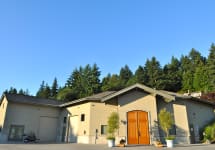Betz Family Winery Possibility 2015
-
Wine
Spectator -
Jeb
Dunnuck -
Robert
Parker


Product Details
Your Rating
Somm Note
Winemaker Notes
Professional Ratings
-
Wine Spectator
Polished and seamlessly built, with expressive blueberry and huckleberry flavors accented by smoky spice and bitter chocolate notes that take on richness toward refined tannins. Cabernet Sauvignon, Syrah, Petit Verdot and Merlot.
-
Jeb Dunnuck
The entry-level cuvée is the 2015 Cuvée Frangin, a mix of both Bordeaux varieties and Rhône varieties. It’s a juicy, medium to full-bodied, rounded red wine that gives up lots of red and black fruits, plenty of herbal notes, and background spice. Enjoy it over the coming 4-5 years.
-
Robert Parker's Wine Advocate
The 2015 Cuvee Frangin is the entry-level cuvee of the estate and is mix of Bordeaux varieties (61%) and Rhône varieties (39%). It’s a smoking value in every vintage and offers medium to full-bodied notes of ripe herbs, tobacco, currants and licorice. Drink this rounded, impressively textured, pleasure-bent beauty anytime over the coming 4-6 years.
Other Vintages
2016-
Wine
Spectator -
Jeb
Dunnuck







By carving out specific vineyard blocks and being meticulous in the vineyard and cellar they are able to achieve the quality they aspire to, the result being highly-acclaimed wines that compete on the world stage.
As importantly over the years our winery culture has become a way of life in which everyone – our growers, winery team and customers are family.
Today, Betz Family Winery is headed by two families, committed to be true to their heritage, their family members and true to what Betz embodies: wines of dimension and pleasure that allow the character of Washington to shine through.

With hundreds of red grape varieties to choose from, winemakers have the freedom to create a virtually endless assortment of blended red wines. In many European regions, strict laws are in place determining the set of varieties that may be used, but in the New World, experimentation is permitted and encouraged resulting in a wide variety of red wine styles. Blending can be utilized to enhance balance or create complexity, lending different layers of flavors and aromas. For example, a red wine blend variety that creates a fruity and full-bodied wine would do well combined with one that is naturally high in acidity and tannins. Sometimes small amounts of a particular variety are added to boost color or aromatics. Blending can take place before or after fermentation, with the latter, more popular option giving more control to the winemaker over the final qualities of the wine.
How to Serve Red Wine
A common piece of advice is to serve red wine at “room temperature,” but this suggestion is imprecise. After all, room temperature in January is likely to be quite different than in August, even considering the possible effect of central heating and air conditioning systems. The proper temperature to aim for is 55° F to 60° F for lighter-bodied reds and 60° F to 65° F for fuller-bodied wines.
How Long Does Red Wine Last?
Once opened and re-corked, a bottle stored in a cool, dark environment (like your fridge) will stay fresh and nicely drinkable for a day or two. There are products available that can extend that period by a couple of days. As for unopened bottles, optimal storage means keeping them on their sides in a moderately humid environment at about 57° F. Red wines stored in this manner will stay good – and possibly improve – for anywhere from one year to multiple decades. Assessing how long to hold on to a bottle is a complicated science. If you are planning long-term storage of your reds, seek the advice of a wine professional.

A large and geographically diverse AVA capable of producing a wide variety of wine styles, the Columbia Valley AVA is home to 99% of Washington state’s total vineyard area. A small section of the AVA even extends into northern Oregon!
Because of its size, it is necessarily divided into several distinctive sub-AVAs, including Walla Walla Valley and Yakima Valley—which are both further split into smaller, noteworthy appellations. A region this size will of course have varied microclimates, but on the whole it experiences extreme winters and long, hot, dry summers. Frost is a common risk during winter and spring. The towering Cascade mountain range creates a rain shadow, keeping the valley relatively rain-free throughout the entire year, necessitating irrigation from the Columbia River. The lack of humidity combined with sandy soils allows for vines to be grown on their own rootstock, as phylloxera is not a serious concern.
Red wines make up the majority of production in the Columbia Valley. Cabernet Sauvignon is the dominant variety here, where it produces wines with a pleasant balance of dark fruit and herbs. Wines made from Merlot are typically supple, with sweet red fruit and sometimes a hint of chocolate or mint. Syrah tends to be savory and Old-World-leaning, with a wide range of possible fruit flavors and plenty of spice. The most planted white varieties are Chardonnay and Riesling. These range in style from citrus and green apple dominant in cooler sites, to riper, fleshier wines with stone fruit flavors coming from the warmer vineyards.
